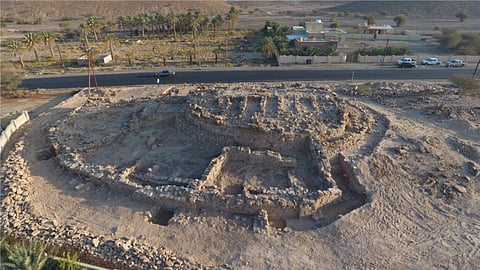Oldest bronze dagger discovered in Oman
Archaeological sites in Ibri province are on the UN’s World Heritage list

Muscat: Excavation work at Al Khatam archeological site in Oman’s northern Ibri province has led to the discovery of the oldest bronze dagger and a collection of decorated stone pots dating back to the second and third millennia BC.
A white limestone rock with a carving of an animal (perhaps a deer or a cow) was also found at the site. It is likely this rock originated from a tomb of the ‘Umm Al Nar period’ (approximately 2600-2200 BC).
The Ministry of Heritage and Culture, in cooperation with the University of Bologna in Italy, completed the third phase of excavations at Al Khatam archaeological tower. The archaeological sites in Ibri province are on the UN’s World Heritage list. The tower features 14 rooms accessed through a central corridor.
The Ministry carries out several rehabilitation and documentation programmes to find answers to the many mysteries the archaeological sites present, in compliance with Unesco’s guiding principles.
Last week, the oldest Bronze Age towers and ‘workshops’ that produced copper, dating back to the 3100 BC, were discovered at an archeological site in Mudhaibi province in eastern Oman. This was linked to the extraction and production of copper.
Many sites and stone towers in the villages and towns of the North A’sharqiyah governorate were discovered and documented. Additionally, prospecting work in mud and stone buildings in Al Khashba area was also undertaken.
A Carbon-14 analysis of the samples proved the site dates back to 3100 BC. Excavations in one of the stone towers indicated it was the oldest tower in Oman, going all the way back to the Bronze Age. The mission discovered what are believed to be the oldest copper production workshops.
In January, 3,000 arrow heads and 10 snake-shaped idols, which were likely to have served as religious symbols in the Iron Age, were discovered in Oman.
The Ministry of Heritage and Culture, in collaboration with a French mission from the Sorbonne University headed by Dr. Geum Gerd, discovered the artifacts at Al Madhmar area of Adam province. Two semi-complete pottery urns and a large number of pottery fragments were also discovered at the site.
The team is continuing archaeological research at the site, in the hope of understanding better the culture and lifestyle of Iron Age communities in the area.
Sign up for the Daily Briefing
Get the latest news and updates straight to your inbox



